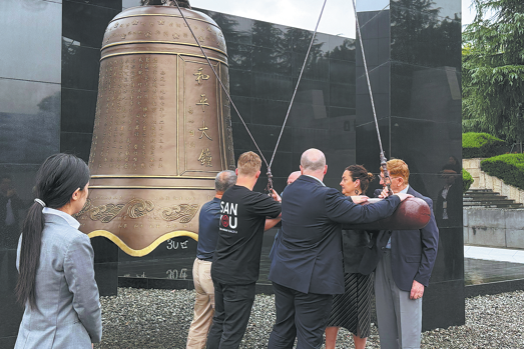In Utah, passion for Chinese study moves online
By ZHAO XU in New York | China Daily Global | Updated: 2020-04-14 11:12

Despite the ongoing coronavirus crisis and the tension surrounding the Sino-US relationship, students and their parents in Utah are showing unabated interest in studying the Chinese language and culture, said Howard Stephenson, a former Utah senator.
"Lingo Bus, a Chinese education company specialized in e-learning, has made a very generous donation of their Chinese language-learning platform and resources to Utah students, to aid them while they are being educated online at home," he said. "It came in mid-March, when it became clear that Utah schools were closing and would remain closed for at least several weeks."
Twelve years ago, when the Dual Language Immersion Program started in Utah schools, Stephenson was one of those who pushed for the inclusion of Chinese in the program, alongside French, German, Russian, Portuguese and Spanish. Participating students receive half of their instruction in English, and the other half in their chosen language on a daily basis for 12 years, beginning from primary school and continuing until they finish high school.
"We had our first graduates a year ago. And our second cohort of graduates will soon leave high school, each one very fluent in one of the six languages," said Stephenson. "While Spanish is very prominent in our hemisphere and is still the No. 1 enrollment in the program, Chinese is the second highest in enrollment and the most requested language by parents, even though our connections to China are separated by the Pacific Ocean."
According to Stephenson, a couple of high schools in Utah will adopt the immersion program this fall, and the focus will be on Chinese. "At the same time, the Chinese-language program will also be introduced in three Utah elementary schools that don't have it now. Since things have been moved online; these openings will not be affected by the current situation," he said.
Currently across the state of Utah, about 15,000 students from 76 schools are studying the Chinese language and culture through the immersion program. And Stephenson is seeing a steady rise in that number.
"These days, more and more parents are clamoring for their children to study Chinese. So as each cohort moves up one grade at the end of a school year, we'll have more new participants than we had the previous year. It's like a pyramid with the continuously expanding base," he said. "I believe that we can easily have 30,000 to 40,000 students enrolled within the next decade."
Dan Stephenson, son of Howard, who has followed in his father's footsteps in getting himself involved with state politics and in pushing for bilateral exchanges between China and the US, pointed to one of the goals of implementing a dual-language immersion program.
"Immersion students are more aware of and show more positive attitudes towards other cultures and an appreciation for other people," he wrote on the Utah State Board of Education website.
The younger Stephenson believes that the increased cultural sensitivity has made students empathetic toward the suffering of Chinese people when the country was convulsed by COVID-19.
"When the crisis was at its peak in China, some Utah school kids wrote messages in Chinese and delivered them to Wuhan," he said, referring to the city in Central China's Hubei province that had suffered the most among all Chinese cities throughout the crisis, with more than 2,500 deaths.
His words were echoed by Darrin Johnson, principal of the Cascade Elementary School in Utah County, Utah.
"Some fourth-grade girls came into my office one day in March saying that they wanted to launch a donation for China," he said. "That was about the time we were starting to close schools down, so we weren't able to follow through. But they clearly have that sentiment."
Previously, the students had watched a music video featuring Chinese doctors and nurses, during their Chinese-language class.
One of the earliest Utah schools to offer Chinese study in a dual-language immersion program, Cascade Elementary now has around 370 students participating in the program, half the schools' enrollment.
"Ethnically, most of them are Caucasian," said the principal, who added that although Utah, with 3 million people constitutes only 1 percent of the US population, it has one-fifth of the country's students studying Chinese.
"Historically, we have a very strong commitment of sending young people all over the world. You could do missions for the church – it's part of the culture of the state," he said. "Learning to live and then accept and be a part of other cultures is really part of the culture here. And those people will eventually come back and become part of the local culture, so we tend to embrace people from other parts of the world."
Before the Chinese Lunar New Year in late January, 50 fourth-graders from Cascade Elementary wrote to Chinese President Xi Jinping, who later wrote back.
Talking about the enthusiasm toward Chinese learning among parents, most of whom do not speak the language themselves, Howard said: "I think you would find this across the nation if we're able to deploy dual-language immersion more broadly across the US. Parents want their children to be associated with the future of China, realizing that China's future is very much America's future."
























